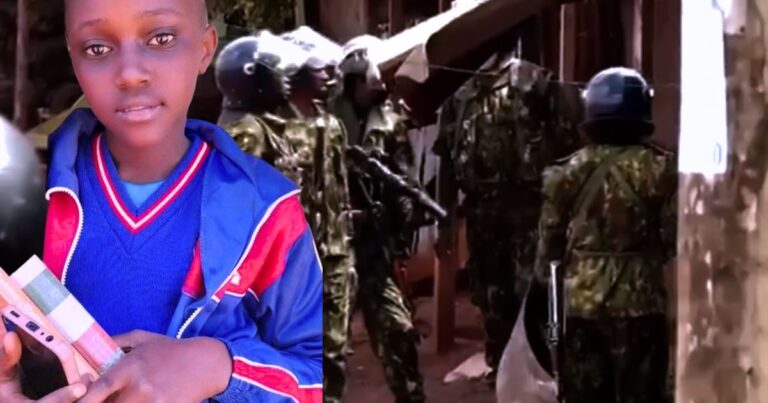On the evening of July 7, 2025, Bridget Njoki Wainaina, a 12-year-old Grade Seven pupil, sat in the living room of her family’s modest home in Kiriguini, Ndumberi, a village in Kiambu County. It was around 6:20 p.m., and she was watching television, a routine activity for the bright, hardworking girl who had stayed home from school due to escalating tensions from the Saba Saba protests. Her mother, Lucy Ngugi, was nearby, unaware that a tragedy was about to unfold. Suddenly, a loud bang echoed through the house, followed by chaos. A stray bullet, allegedly fired by police during clashes with protesters two kilometers away on the Kiambu-Limuru Road, pierced the thin iron-sheet wall of their home and struck Bridget in the head. “I saw blood on her hands and thought she had been scratched,” Lucy recounted to TV47, her voice breaking. “When I checked, I saw a bullet hole in her head, and she collapsed.”
The family, with help from neighbors, rushed Bridget to St. Brigid’s Hospital. Doctors found a bullet lodged in her skull and attempted resuscitation, but her heart had stopped. Despite their efforts, Bridget was pronounced dead that evening, leaving her family and community in profound grief. “Bridget alikuwa mtoto mzuri, hakuwa na tabia mbaya, alikuwa anasoma vizuri,” Lucy wept, describing her daughter as a respectful child with big dreams.
The Saba Saba protests, marking the anniversary of Kenya’s historic 1990 pro-democracy demonstrations, have taken on new significance in 2025, fueled by economic and governance grievances. On July 7, young Kenyans, including many from the Gen-Z movement, took to the streets nationwide, with Ndumberi seeing unexpected unrest for a typically calm village. Clashes between protesters and police escalated, with reports of tear gas, rubber bullets, and live ammunition used to disperse crowds. The violence claimed at least 11 lives across Kenya, including six in Kiambu County alone, with Bridget among the victims.
Local residents accused police of reckless tactics, noting that Bridget’s home was far from the protest zone. “Ndumberi is a village, not a town center,” said Margaret Wangui, another grieving mother who lost her son, Laban Kamau, in the same protests. “We’ve never seen such violence here.” The use of live bullets, condemned by human rights groups, has reignited debates about police brutality, with the Kenya National Commission on Human Rights (KNCHR) reporting over 100 protest-related injuries since 2023.
Bridget’s death has left her family grappling with both emotional and financial burdens. The mortuary and post-mortem costs at Kiambu Level Five Hospital, estimated at KSh 30,000–50,000, have added to their distress, prompting calls for the government to cover these expenses. “The killings were uncalled for,” Lucy told reporters, echoing demands for justice and compensation, which could reach KSh 1 million for wrongful death claims, according to legal experts.
The Ndumberi community has rallied around the family. Vigils have been held, and her story has been shared to raise support. The outpouring of grief has extended beyond Ndumberi, with hashtags like #JusticeForBridget trending on social media, reflecting national outrage.
The tragedy has intensified scrutiny of police conduct during protests. The Independent Policing Oversight Authority (IPOA) is investigating, with early indications pointing to a police-fired bullet as the cause of Bridget’s death. Human rights organizations, including Amnesty International Kenya, have called for transparent investigations and stricter regulations on live ammunition. “No child should die in their own home at the hands of police,” a KNCHR activist said during a Kiambu vigil.
However, government officials defend police actions, citing the difficulty of managing volatile protests. “Officers face hostile crowds, and their safety is also at risk,” a Ministry of Interior spokesperson stated. This perspective has drawn criticism, with activists arguing that excessive force disproportionately harms bystanders like Bridget. Reports of “goons” allegedly hired to disrupt protests have further complicated the narrative, with residents claiming police target innocent individuals while sparing agitators.
Bridget’s death has become a symbol of the human cost of Kenya’s protest violence. Local leaders, including former Kiambu MP Jude Njomo, have demanded an independent inquiry, while Githunguri MP Gathoni Wamuchomba condemned Interior CS Kipchumba Murkomen’s reported “shoot-to-kill” order. Proposed reforms include body cameras for officers, community policing initiatives, and restrictions on live bullets in residential areas, where homes with thin walls are particularly vulnerable.
As Ndumberi mourns, the nation faces a reckoning. Bridget’s dreams—of education and a bright future—were cut short, but her story has galvanized calls for change. Kenyans are urged to support peaceful dialogue and advocate for policies that prioritize civilian safety, ensuring no more children pay the price of unrest.


